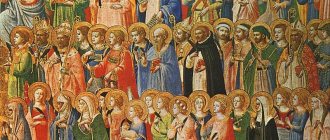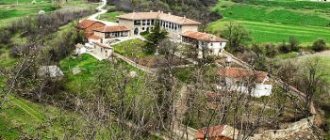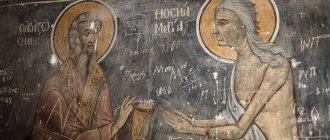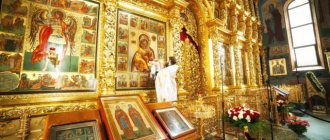Venerable Paraskeva Petka of Serbia
October 26th 2015 —
Memory 14/27 October
Paraskeva of Serbia, Saint Paraskeva, Paraskeva Friday, Tarnovskaya, Bulgarian, Moldavian (Serbian: Sveta Petka; Bulgarian: Petka Bulgarska; 11th century) is a Christian saint, famous for her asceticism. He is revered among the saints.
She was born in the city of Epivat (Επιβάτες, now Selimpasha (English) Russian near Istanbul in Turkey) on the shores of the Sea of Marmara not far from Constantinople.
In addition to their daughter Paraskeva, they had a son. They sent him to school, and his daughter was raised in the house of her pious parents. Paraskeva's brother, when he was sufficiently taught the Holy Scriptures, with the consent of his parents, took monastic vows under the name of Euthymius. Euthymius later became a bishop in Madita, where he became famous for his virtuous life and, during his life and after his death, performed many glorious miracles.
After the death of her parents, Paraskeva distributed the inheritance she received and went to Constantinople, where she lived for five years. There she took monastic vows and went to the Holy Land to worship shrines. After the pilgrimage, she settled as a hermit in the desert in the Jordan Valley and began to lead an equal-angelic life here. Imitating the God-seer, the prophet Elijah and John the Baptist, she ate only desert grains, consuming them only in small quantities, and then only after sunset.
Gradually melting, now from the heat, now from the cold, she turned her gaze only to the One God, who can save the humble in heart and hide from the whirlwind, from the storm (Ps 54:9). Who can tell how many tears the saint shed? Who will tell about her frequent and incessant lamentations? Who will convey in detail about her constant kneeling and various physical feats? Only the All-Seeing God looked at the exploits of the saint. She had no worries there about worldly vanity: she only cared about the purification of the soul, about the answer to the future judgment and the meeting with the Heavenly Bridegroom. “I’m looking for you, my groom!” - said the Monk Paraskeva and constantly kept in mind the saying of the book of Song of Songs: “Tell me whom my soul loves” (Song 1, 16). She cared most about how to decorate her lamp and, together with the wise virgins, go out to meet the Heavenly Bridegroom, hear His sweet voice and enjoy the sight of His beauty. “When will I come and appear before the face of God?” (Ps 41:3) - the saint continually spoke.
When, therefore, the Monk Paraskeva was in the desert, the crafty enemy envied her virtues and tried to frighten her with dreams and ghosts. Repeatedly turning into various animals, he rushed towards the saint in order to create an obstacle for her on the path of her exploits. But the good bride of Christ, Paraskeva, “You have chosen the Most High as your refuge” (Ps. 90:9) and with His help, through the sign of His holy cross, drove away enemies and tore apart, like a web, all the machinations of the devil, and completely overthrew him. The saint, despite her feminine nature, had a truly masculine mind and defeated the devil, like David defeated Goliath. Having adorned her soul with such deeds and virtues, Paraskeva became the beloved bride of Christ, so that the prophetic words were fulfilled on her: “And the King will desire your kindness” (Ps 44:12). So this King dwelt in her with the Father and the Holy Spirit and remained in her as in His holy church, for Saint Paraskeva, having preserved her soul from sin and defilement, became the church of the Living God.
One night, Paraskeva, after a long stay in the desert, as usual, with tenderness stretching out her hands to the sky, stood in prayer. Suddenly, in the form of a bright young man, she saw an angel of God, who, approaching her, said: “Leave the desert and return to your fatherland, for there it is fitting for you to leave your body on earth and go to the Lord with your soul.”
The venerable woman, having penetrated into the meaning of the vision, realized that it reflected God’s command; She rejoiced that the time of her release from the body was near, but she was sorry to part with desert solitude, for nothing purifies the soul and brings it closer to the Prototype than desert and silence. Two years before her death, she returned home in old age.
Arriving in the reigning city of Constantinople, she entered the beautiful temple of the Wisdom of God there, also visited the Blachernae church and, bowing before the miraculous icon of the Mother of God, went to her homeland in Epivatus, where she lived for some time, without changing her usual desert feat - fasting and prayers. When the time came for her departure to God, Paraskeva prayed earnestly for herself and for the whole world, and during prayer she betrayed her blessed soul to God. Her body was buried by believers, according to Christian custom, but not in a common cemetery - like the body of a wanderer who did not tell anyone about herself where she was from.
God, who wanted to glorify his saint, after many years, revealed her relics.
Sermons:
Rev. Paraskeva (The great significance of the Temple of God for Christians). Prot. Grigory Dyachenko
The Life reports that the relics of Paraskeva were miraculously found and placed in a local church, where they became famous for various miracles. In 1238, by order of the Bulgarian Tsar John Asen, they were transferred to the city of Tarnovgrad. After the capture of Bulgaria by the Turks, the relics of Paraskeva were taken to Wallachia, and when it was captured, at the request of the Serbian princess Milica they were allowed to be transferred to Belgrade.
When Suleiman I captured Belgrade in 1521, among other valuables, he took the relics of St. Paraskeva to Constantinople. In 1641, at the request of the Moldavian ruler Vasily, they were allowed to be moved to Iasi, where they remain to this day.
Saint Paraskeva is considered the patroness of Moldavia, since the location of her relics is the city of Iasi, which was the ancient capital of historical Moldavia.
The image of Saint Paraskeva in the lands of the Eastern Slavs closely merged with the ancient cult of pagan Mokosha, to whom women dedicated Friday. Among the people, the saint received the double name Paraskeva-Friday.
The Russian people called Saint Paraskeva - Friday, Pyatina, Petka. The Russified form of the name was popular - Praskovya, reduced. Parasha, Pana.
Paraskeva is considered the patroness of women's winter work, primarily yarn. From this day on, they begin to crumple and fray the flax: “crumple and crush the flax from the dirt.”
The main content of these holidays is the observance of prohibitions on “women’s” work, as well as sacrifices, going to springs, and prayer services.
For Belarusian Catholics and Polishchuks on this day: “you cannot spin, plow, take out ashes and make lye for washing clothes.”
In Polesie there was a special Friday icon: “Friday is such a dark icon. Dull, sad woman sits and prade tow.”
Paraskeva Pyatnitsa was considered a “woman’s saint” - “since our peasant women everywhere consider her their intercessor.” Paraskeva, just like the Virgin Mary on the Intercession, the girls prayed for marriage: “Friday, holy martyr Paraskveya, send me a groom as soon as possible!” (Arkhangelsk province)[2]. Or they could make a slander on the comb: “I will begin to put on the comb, the servant of God (name), and invite suitors to come to me. Just as bees fly to honey and look at flowers, so suitors would hurry to me. In the name of the Father and the Son and the Holy Spirit. Amen". After the slander, the girl wore a comb for seven days in a row[12].
If any knocking was heard in a woman’s closet at night, then the hostess, walking around the corners of the house with a tow or yarn, would kindly and affectionately say:
Noise, noise, what did you realize? Al with joy? Al with sadness? If you are in joy, knock, If you are in grief, be silent! Come yesterday!
Life of Saint Paraskeva
The life of the holy Equal-to-the-Apostles Martyr Paraskeva tells the following: she was born in Rome, into a family of pious Christians: Agathon and Politia. They had no children for a long time, and only after fervent prayers did the Lord give them their only daughter Paraskeva, so named because she was born on Friday (Paraskeva - Friday, Greek). The dates of her birth and death are not precisely known.
Her life dated back to the reign of the Roman Emperor Antoninus. Two Antonines ruled in Rome - Antoninus Pius (138-161 AD) and Antoninus the Philosopher (161-180 AD) and during whose reign Paraskeva lived is unknown.
The parents raised their daughter in the spirit of true Christianity, and this education was not in vain. After their death, Paraskeva distributed all her property to the poor and devoted herself to apostolic labors - preaching the Gospel.
She gave her first sermon in Rome, and here she suffered her first suffering. Emperor Antonin received a denunciation of a brave Christian woman. He ordered the ascetic to be brought to him and tried, both with caresses and threats, to force her to renounce her faith in Christ. Paraskeva was unshakable, and the angry emperor ordered her to be tortured. A red-hot copper helmet was placed on her head, but this terrible weapon did not bring any harm to the saint.
Then a new order followed - to throw Paraskeva into a copper cauldron with boiling resin and oil, but the saint remained unharmed here too. The emperor doubted whether the resin in the cauldron was really melted, and imprudently ordered Paraskeva to throw liquid into it. She scooped it out of the cauldron with her hand and splashed it in his face.
Severe burns and blindness were punishment for the cruel ruler. Suffering from unbearable pain, seeing nothing, the recent tormentor begged his victim: “Servant of the true God,” he asked, “have mercy on me and return light to my eyes, so that I too can believe in the God you preach.” Through prayer, the holy emperor was immediately healed, received his sight, and together with his entourage accepted Christianity.
Released in peace, Paraskeva went to other lands to preach Christianity. She came to the city where a certain Asklipius ruled. And this ruler, like Emperor Antonin, tried to reject Paraskeva from preaching the Gospel, but, not achieving what he wanted, he condemned her to death. According to custom, death row prisoners were given to be devoured by a terrible serpent who lived near the city. The saint remembered the words of the Lord: “They take away the serpent, and even if they drink of death, it does not harm them” (Mark 16:18). She fearlessly approached the monster, made the sign of the cross over it, after which it split in two and disappeared. This miracle enlightened the pagans, and all the local people believed in the Lord Jesus Christ.
Finally, Saint Paraskeva ended up in a place ruled by a man named Tarasius. And here the saint preached Christianity, for which she was given over to terrible torture. Tarasius, seeing that the saint was unshakable, ordered her head to be cut off. Thus, the holy martyr Paraskeva crowned her apostolic labors with martyrdom for the name of Christ. The relics of the venerable head of the holy venerable martyr Paraskeva are located on Athos, in the Russian Panteleimon Monastery. A particle of Paraskeva’s relics is also present in the monastery.
Local Crimean residents firmly believed that it was here, in the remote tract of Toplu, that Saint Paraskeva met her death, and the spring began to flow at the very time when the earth was stained with the blood of the venerable martyr. The holiness of these legends was confirmed by the fact that this spring was healing, and every year on July 26 (old style) people flocked here not only from the surrounding area, but also from distant places (it is interesting that local Tatars, along with Christians, revered the spring and called it Chokrak- Sagly-Su is a source of living, healthy water).
A prayer service was served with the blessing of water, water was filled into vessels and taken home. There was not yet a road or a single building here, only a spring flowed through a dense forest, and people, with difficulty making their way through ravines and forest growth, brought their prayers, their hopes and aspirations here, were consoled and healed, and this was the best evidence of this that the holy martyr Paraskeva does not leave these places with her mercy.
And, of course, irrefutable confirmation of this was the discovery in the source of an icon with the image of the holy martyr Paraskeva, which the Greeks took with them during the resettlement to the Azov region in 1778. The found icon was in Mariupol, in the Church of the Nativity of the Virgin Mary, and enjoyed special respect - according to According to legend, she saved Mariupol from cholera. Since then, on the day of the miracle (July 26, old style), only women gathered in the church and celebrated a kind of “women's panair” (church holiday).
Customs of the Eastern Slavs
The Torment of St.
Paraskeva with fire. The mark of a hagiographic icon. Main article: Paraskeva Pyatnitsa
The image of Saint Paraskeva in the lands of the Eastern Slavs closely merged with the ancient cult of pagan Mokosha, to whom women dedicated Friday. Among the people, the saint received the double name Paraskeva-Friday.
The Russian people called Saint Paraskeva - Friday, Pyatina, Petka
.
The Russified form of the name was popular - Praskovya
, dimin.
Parasha
,
Pana
.
In Russian life in the old days, Saint Paraskeva was called: “Paraskeva-Friday”. The word “Friday” almost turned into an independent female name that could exist next to Praskovya, like the names Warrior and Faster.
Literature
- Paraskeva Pyatnitsa / Levkievskaya E. E., Tolstaya S. M. // Slavic antiquities: Ethnolinguistic dictionary: in 5 volumes / edited by. ed. N. I. Tolstoy; Institute of Slavic Studies RAS. — M.: Intl. relations, 2009. - T. 4: P (Crossing the water) - S (Sieve). — P. 631-633. — ISBN 5-7133-0703-4, 978-5-7133-1312-8.
- Life of the Venerable Paraskeva // Lives of the saints in Russian, set out according to the guidance of the Chetyih-Menya of St. Demetrius of Rostov: 12 books, 2 books. add. - M.: Moscow. Synod. typ., 1903-1916. - Vol. II: October, Day 14. - P. 343.







